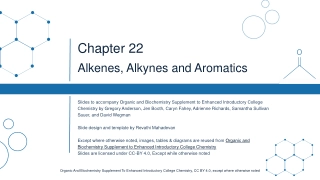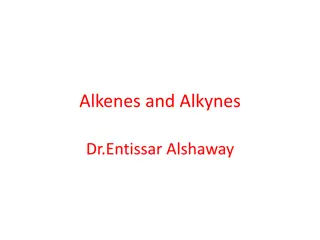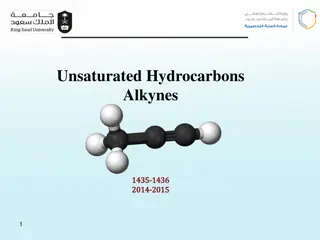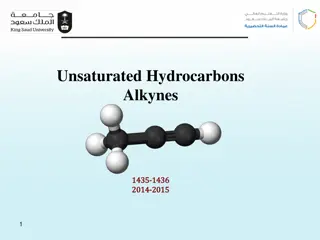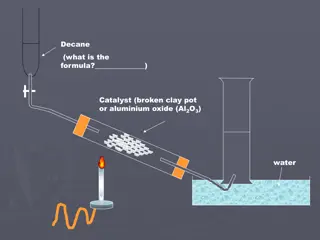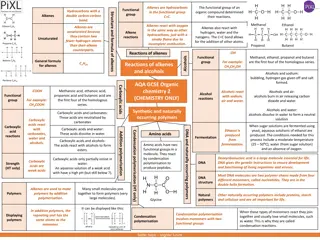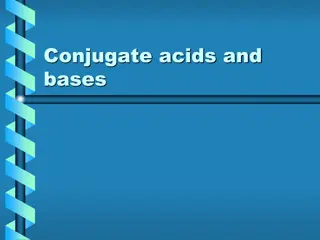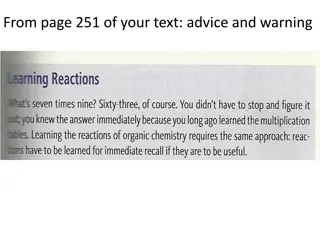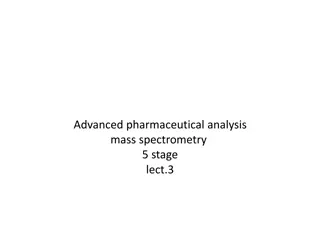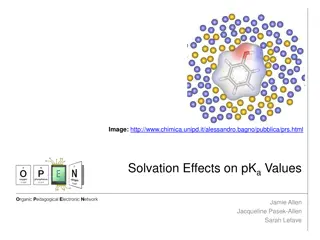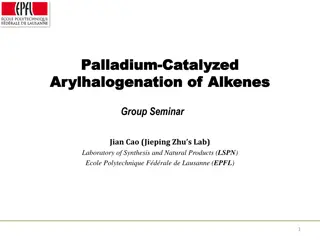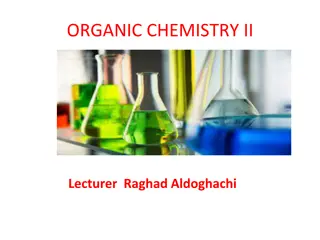Understanding Alkenes, Alkynes, and Conjugate Dienes in Organic Chemistry
Alkenes and alkynes are unsaturated compounds with carbon-carbon double and triple bonds, respectively. Dienes contain two double bonds that can be cumulated, conjugated, or nonconjugated. Learn about their nomenclature and classification in this informative guide.
Download Presentation

Please find below an Image/Link to download the presentation.
The content on the website is provided AS IS for your information and personal use only. It may not be sold, licensed, or shared on other websites without obtaining consent from the author. Download presentation by click this link. If you encounter any issues during the download, it is possible that the publisher has removed the file from their server.
E N D
Presentation Transcript
PRINCIPLES OF ORGANIC CHEMISTRY Mr.OM PRAKASH PANDA 1 Dr Mohamed El-Newehy CHAPTER 3 ALKENES, ALKYNES & CONJUGATE DIENES 2 Dr Mohamed El-Newehy 1
DEFINITION AND CLASSIFICATION o Alkenes (Olefins) are unsaturated compounds containing carbon carbon double bonds. o Alkynes (Acetylenes) are unsaturated hydrocarbons containing carbon carbon triple bonds. o General formulas are CnH2n Alkenes CnH2n-2 Alkynes o Alkenes and Alkynes have physical properties similar to those of alkanes. o Alkynes, are similar to Alkenes in their physical properties and chemical behavior. o The simplest members of the Alkenes and Alkynes series are C2 & C3. DEFINITION AND CLASSIFICATION Dienes (Alkadienes) Compounds with two double bonds are present, the compounds are called alkadienes or , more commonly, dienes. Depending on the relative positions of the multiple bonds, double bonds are said to be: o Cumulated; when they are right next to one another. o Conjugated; when multiple bonds alternate with single bonds. o Nonconjugated; when more than one single bond comes between multiple bonds. 4 Dr Mohamed El-Newehy 2
NOMENCLATURE Common Names o The simplest members of the alkene and alkyne series are frequently referred to by their older common names, ethylene, acetylene, and propylene. o T wo important groups also have common names; They are the vinyl and allyl groups. These groups are used in common names. 5 Dr Mohamed El-Newehy NOMENCLATURE The IUPAC Rules The IUPAC rules for naming alkenes and alkynes are similar to those for alkanes, but a few rules must be added for naming and locating the multiple bonds. 1. The ending -ene is used to a carbon carbon double bond. The ending -yne is used for a carbon carbon triple bond 2. Select the longest chain that includes both carbons of the double or triple bond. 3. Number the chain from the end nearest the double or triple bond so that the carbon atoms in that bond have the lowest possible numbers. 6 Dr Mohamed El-Newehy 3
NOMENCLATURE The IUPAC Rules 4. Indicate the position of the multiple bond using the lower numbered carbon atom of that bond. 5. If more than one multiple bond is present, number the chain from the end nearest the first multiple bond. 7 Dr Mohamed El-Newehy NOMENCLATURE NOTE root of the name (eth- or prop-) tells us the number of carbons, and the ending o The (-ane, -ene, or -yne) tells us whether the bonds are single, double, or triple. o The first two members of each series are No number is necessary in these cases, because in each instance, only one structure is possible. 8 Dr Mohamed El-Newehy 4
NOMENCLATURE NOTE four carbons, a number is necessary to locate the double bond or triple bond. With o o Branches are named in the usual way . 9 Dr Mohamed El-Newehy NOMENCLATURE 10 Dr Mohamed El-Newehy 5
NOMENCLATURE Cycloalkenes o We start numbering the ring with the carbons of the multiple bond. o In cyclic alkenes, a number is not needed to denote the position of the functional group, because the ring is always numbered so that the double bond is between carbons 1 and 2. 6 2 5 CH3 3 CH3 2 1 1 3 CH2CH3 1 4 4 2 6 CH3 5 4 CH2CH3 3 5 3-Ethylcyclopentene 4,5-Dimethylcyclohexene 4-Ethyl-3-methylcyclohexene 2- lopentene 5-EthylcX Cyclopentene CycX yclopentene 11 Dr Mohamed El-Newehy NOMENCLATURE Cycloalkenes o Put the lowest substituent number into the name not in the direction that gives the lowest sum of the substituent numbers. o Example; 1,6-dichlorocyclohexene dichlorocyclohexene has the lowest substituent number (1), even though it does not have the lowest sum of the substituent numbers (1+6=7 versus 2+3=5). is not called 2,3-dicyclohexene because 1,6- Cl H3CH2C CH3 Cl 6 6 1 2 1 5 2 5 3 4 3 4 1,6-Dichlorocyclohexene 5-Ethyl-1-methylcyclohexene NOT NOT 2,3-Dichlorocyclohexene because 1<2 4-Ethyl-2-methylcyclohexene because 1<2 12 Dr Mohamed El-Newehy 6
NOMENCLATURE Example: Write the structural formula of 4-Isopropyl-3,5-dimethyl-2-octene. 1) The parent carbon chain is an Octene. The double bond is located between the 2nd and 3rd carbons. 2) Two methyl groups are attached on the parent carbon chain, one on carbon 3 and the other on carbon 5. 3) An isopropyl group is attached on carbon 4. 4) Put the missing hydrogens to get the correct structure. 13 Dr Mohamed El-Newehy PHYSICAL PROPERTIES OF ALKENES AND ALKYNES o Physical State Alkenes and alkynes occur at room temperature are gases, liquids, and solids. C2 to C4 are gases, C5 to C17 are liquids, C18 and larger alkenes are wax like solids. o Solubility Alkenes are nonpolar compounds. Alkenes are soluble in the nonpolar solvents; CCl4 and benzene, Alkenes are insoluble in polar solvents like water . o Boiling Points & Melting Points The boiling points and melting points of normal hydrocarbons increase with increasing molecular weight. The greater the number of branches, the lower the boiling point. 14 Dr Mohamed El-Newehy 7
CisTrans ISOMERISM IN ALKENES (GEOMETRIC ISOMERISM) o Because rotation at carbon carbon double bonds is restricted, cis trans isomerism (geometric isomerism) is possible in substituted alkenes. A. When W differs from X and Y from Z, Alkenes exist as geometric isomers o For example; 1,2-dichloroethene exists in two different forms: 15 Dr Mohamed El-Newehy Cis Trans ISOMERISM IN ALKENES (GEOMETRIC ISOMERISM) cis isomer; when two similar groups are on the same side of the double bond. trans isomer; when two similar groups are on the opposite sides of the double bond. o They have different physical properties and can be separated by fractional crystallization or distillation. B. If (W = X or Y = Z), geometric isomerism is not possible. 16 Dr Mohamed El-Newehy 8
CisTrans ISOMERISM IN ALKENES (GEOMETRIC ISOMERISM) o For alkenes with four different substituent such as Cl > F , and CH3 > H Another system, the E, Z system, Basically, the E,Z system works as follows; - Arrange the groups on each carbon of the C=C bond in order of priority (depends on atomic number) - The higher the atomic number of the atom directly attached to the double- bonded carbon, the higher the priority . 17 Dr Mohamed El-Newehy Cis Trans ISOMERISM IN ALKENES (GEOMETRIC ISOMERISM) o If the two groups of higher priority are on the same side of the C=C plane, The isomer is labeled Z; (from the German zusammen, together). o If the two groups of higher priority are on opposite sides of the C=C plane, The isomer is labeled E; (from the German entgegen, opposite). 18 Dr Mohamed El-Newehy 9
ACIDITY OF ALKYNES o A hydrogen atom on a triply bonded carbon is weakly acidic and can be removed by a very strong base. o Consider the hybridization of the carbon atom in each type of C - H bond: Recall that s orbitals are closer to the nucleus than are p orbitals. Consequently, the bonding electrons are closest to the carbon nucleus in the triple bond, making it easiest for a base to remove that type of proton. Sodium amide is a sufficiently strong base for this purpose. 19 Dr Mohamed El-Newehy PREPARATION OF ALKENES o Alkenes are prepared by Elimination of an atom or group of atoms from adjacent carbons to form carbon-carbon double bond. 1) Dehydration of Alcohols o When an alcohol is heated in the presence of a mineral acid catalyst, It readily loses a molecule of water to give an alkene. The acid catalysts most commonly used are sulfuric acid, H2S04, and phosphoric acid, H3P04. 20 Dr Mohamed El-Newehy 10
PREPARATION OF ALKENES 1) Dehydration of Alcohols 21 Dr Mohamed El-Newehy PREPARATION OF ALKENES 1) Dehydration of Alcohols Which Alkene Predominates?; Saytzeff s Rule The loss of water from adjacent carbon atoms, can give rise to more than one alkene. Example: the dehydration of 2-butanol. 2-butene is the major (with two substituents attached to C=C) alkyl Saytzeff s Rule applies In every instance in which more than one Alkene can be formed The major product is always the alkene with the most alkyl substituents attached on the double-bonded carbons. 22 Dr Mohamed El-Newehy 11
PREPARATION OF ALKENES 1) Dehydration of Alcohols Mechanism of Dehydration of Alcohols Step 1. Protonation of the alcohol. Step 2. Formation of a carbocation. Step 3. Loss of a proton from the carbocation. regenerates the acid catalyst and forms the alkene. 23 Dr Mohamed El-Newehy PREPARATION OF ALKENES 1) Dehydration of Alcohols o Classes of Carbocations according to the number of carbon atoms attached to the positively charged carbon. Generally 1. The dehydration of alcohols requires an acid catalyst. 2. The predominant alkene formed follows Saytzeffs rule. 3. The reaction proceeds via a carbocation intermediate. 4. The stabilities of carbocations and the ease of dehydration of alcohols follows the order 3 > 2 > 1 . 24 Dr Mohamed El-Newehy 12
PREPARATION OF ALKENES 2) Dehydrohalogenation of Alkyl Halides o Alkenes can also be prepared under alkaline conditions. heating an alkyl halide with a solution of KOH or NaOH in alcohol, yields an alkene. 3) Dehalogenation of Vicinal Dibromides 25 Dr Mohamed El-Newehy PREPARATION OF ALKYNES 1) Dehydrohalogenation of Alkyl dihalides o Treatment of vicinal dihalides with strong base followed by sodium amide. o This general method for the conversion of alkenes to alkynes. 26 Dr Mohamed El-Newehy 13
PREPARATION OF ALKYNES 2) Reaction of Sodium Acetylide with Primary Alkyl Halides Acetylene Monosubstituted Acetylenes 27 Dr Mohamed El-Newehy REACTIONS OF ALKENES o The chemistry of alkenes can be divided into two general types of reactions: (1) Electrophilic Addition Reactions The bond is localized above and below the C-C bond. The electrons are relatively far away from the nuclei and are therefore loosely bound. The double bond acts as a nucleophile (attacks the electrophile). 28 Dr Mohamed El-Newehy 14
REACTIONS OF ALKENES (1) Electrophilic Addition Reactions Addition of Symmetric and Unsymmetric Reagents to Symmetric Alkenes. 1. Addition of Hydrogen: Catalytic Hydrogenation 2. Addition of Halogens: Halogenation Addition of Unsymmetric Reagents to Unsymmetric Alkenes; Markovnikov s Rule. 1. Addition of Hydrogen Halides 2. Addition of Sulfuric Acid 3. Addition of Water: Hydration 4. Addition of HOX: Halohydrin Formation (2) Oxidation Reactions 1. Ozonolysis 2. Oxidation Using KMnO4 29 Dr Mohamed El-Newehy REACTIONS OF ALKENES ELECTROPHILIC ADDITION REACTIO o Reagents and alkenes can be classified as either symmetric or unsymmetric with respect to addition reactions. If a reagent and/or an alkene is symmetric, only one addition product is possible. But if both the reagent and the alkene are unsymmetric, two products are possible. NS 30 Dr Mohamed El-Newehy 15
REACTIONS OF ALKENES ELECTROPHILIC ADDITION REACTIO NS 1. Addition of Hydrogen: Hydrogenation Addition of a mole of hydrogen to carbon-carbon double bond of Alkenes in the presence of suitable catalysts to give an Alkane. 31 Dr Mohamed El-Newehy REACTIONS OF ALKENES ELECTROPHILIC ADDITION REACTIO NS 2. Addition of Halogen: Halogenation When an alkene is treated at room temperature with a solution of bromine or chlorine in carbon tetrachloride to give the corresponding vicinal dihalide (two halogens attached to adjacent carbons) 32 Dr Mohamed El-Newehy 16
REACTIONS OF ALKENES ELECTROPHILIC ADDITION REACTIO 3. Addition of Acids o A variety of acids add to the double bond of alkenes. The hydrogen ion (or proton) adds to one carbon of the double bond, and the remainder of the acid becomes connected to the other carbon. NS Acids that add in this way are the hydrogen halides (H-F , H-Cl, H-Br , H-I), sulfuric acid (H-OSO3H) and water (H-OH). Note that -Any electron-deficient species is called an electrophile. -Any electron-rich species is called a nucleophile. 33 Dr Mohamed El-Newehy REACTIONS OF ALKENES ELECTROPHILIC ADDITION REACTIO NS 3. Addition of Acids o The addition of H A to an alkene is believed to be a two-step process. Step 1. The hydrogen ion (the electrophile) attacks the -electrons of the alkene, forming a C H bond anda carbocation. Step 2. The negatively charged species A: - (a nucleophile) attacks the carbocation and forms a new C A bond. 34 Dr Mohamed El-Newehy 17
REACTIONS OF ALKENES ELECTROPHILIC ADDITION REACTIO 3.1. Addition of Hydrogen Halide NS Alkenes react with hydrogen chloride, HC1, hydrogen bromide, HBr and hydrogen iodide, HI, to form alkyl halides, RX. 35 Dr Mohamed El-Newehy REACTIONS OF ALKENES ELECTROPHILIC ADDITION REACTIO 3.1. Addition of Hydrogen Halide NS Markovnikov s Rule In electrophilic addition of H X to Unsymmetrical Alkenes the hydrogen of the hydrogen halide adds to the double-bonded carbon that bears the greater number of hydrogen atoms and the negative halide ion adds to the other double-bonded carbon. 36 Dr Mohamed El-Newehy 18
REACTIONS OF ALKENES ELECTROPHILIC ADDITION REACTIO NS 37 Dr Mohamed El-Newehy REACTIONS OF ALKENES ELECTROPHILIC ADDITION REACTIO Explanation for Markovnikov s Rule Example; the addition of HBr to propene NS o In modern terms Markovnikov s rule can be restated: The addition of an unsymmetrical reagent HX to an unsymmetrical alkene proceeds in such a direction as to produce the more stable carbocation. 38 Dr Mohamed El-Newehy 19
REACTIONS OF ALKENES ELECTROPHILIC ADDITION REACTIO 3.2. Addition of Water: Hydration If an acid catalyst is present, water (as H-OH) adds to alkenes and the product is alcohol. NS 39 Dr Mohamed El-Newehy REACTIONS OF ALKENES ELECTROPHILIC ADDITION REACTIO NS 3. Addition of HOX: Halohydrin Formation o When an alkene is treated with aqueous chlorine or aqueous bromine, the addition product is a halohydrin. When Cl2 is used, the product is a chlorohydrin. When Br2 is used, the product is a bromohydrin. 40 Dr Mohamed El-Newehy 20
REACTIONS OF ALKENES ELECTROPHILIC ADDITION REACTIO NS 3. Addition of HOX: Halohydrin Formation o The reaction proceeds as if hypochlorous acid, HO Cl, or hypobromous acid, HO Br, were the adding reagent. The electrophile is chloronium ion, Cl+, or bromonium ion, Br+. The nucleopbile is hydroxide ion, OH-. o Addition of HOX also follows Markovnikov s rule. 41 Dr Mohamed El-Newehy REACTIONS OF ALKENES ELECTROPHILIC ADDITION REACTIO NS 4. Hydroboration of Alkenes o There is also a way to obtain anti-Markovnikov oriented alcohols: hydroboration. o One great advantage of this hydroboration-oxidation sequence is that it provides a route to alcohols that cannot be obtained by the acid-catalyzed hydration of alkenes. 42 Dr Mohamed El-Newehy 21
REACTIONS OF ALKENES OXIDATION REACTIONS 1. Ozonolysis o The first product, a molozonide, is formed by cycloaddition of the oxygen at each end of the ozone molecule to the carbon carbon double bond. o This product then rearranges rapidly to an ozonide (explosive if isolated). o They are usually treated directly with a reducing agent, commonly zinc and aqueous acid, to give carbonyl compounds as the isolated products. 43 Dr Mohamed El-Newehy REACTIONS OF ALKENES OXIDATION REACTIONS 1. Ozonolysis o Ozonolysis can be used to locate the position of a double bond. o For example, ozonolysis of 1-butene gives two different aldehydes, whereas 2- butene gives a single aldehyde. 44 Dr Mohamed El-Newehy 22
REACTIONS OF ALKENES OXIDATION REACTIONS 2. Oxidation Using KMnO4 Alkenes react with alkaline potassium permanganate to form glycols (compounds with two adjacent hydroxyl groups). 45 Dr Mohamed El-Newehy ELECTROPHILIC ADDITION REACTIONS OF ALKYNES 1. Addition of Hydrogen: Hydrogenation o T wo hydrogen atoms are added across the double bond of an alkene, resulting in a saturated alkane. 46 Dr Mohamed El-Newehy 23
ELECTROPHILIC ADDITION REACTIONS OF ALKYNES 1. Addition of Hydrogen: Hydrogenation o However, a special palladium catalyst (Lindlar s catalyst) can control hydrogen addition so that only one mole of hydrogen adds (the product is cis alkene). o Reduction of alkynes to trans alkenes using Na/NH3. 47 Dr Mohamed El-Newehy ELECTROPHILIC ADDITION REACTIONS OF ALKYNES 2. Addition of Halogen: Halogenation Bromine adds as follows; In the first step, the addition occurs mainly trans. 3. Addition of Hydrogen Halide With unsymmetric triple bonds and unsymmetric reagents, Markovnikov s Rule is followed in each step. 48 Dr Mohamed El-Newehy 24
ELECTROPHILIC ADDITION REACTIONS OF ALKYNES 4. Addition of Water: Hydration - Addition of water to alkynes requires not only an acid catalyst but mercuric ion as well. - Although the reaction is similar to that of alkenes, the initial product a vinyl alcohol or enol- rearranges to a carbonyl compound. 49 Dr Mohamed El-Newehy CONJUGATED DIENES ALLYLIC CATION In an allylic cation, a carbon carbon double bond is adjacent to the positively charged carbon atom. o The carbocation intermediate in these reactions is a single species, a resonance hybrid. o This type of carbocation, with a carbon carbon double bond adjacent to the positive carbon, is called an allylic cation. o The parent allyl cation, shown below as a resonance hybrid, is a primary carbocation, but it is more stable because its positive charge is delocalized over the two end carbon atoms. 50 Dr Mohamed El-Newehy 25
CONJUGATED DIENES ALLYLIC CATION Allylic Cation An allylic cation is a resonance-stabilized carbocation in each of the two resonance forms of which the formal charge of +1 is on an allylic carbon. The lightest allylic carbocation (1) is called the allyl carbocation. (Primary Allylic cation). 51 Dr Mohamed El-Newehy CONJUGATED DIENES ALLYLIC CATION Secondary Allylic Cation Tertiary Allylic Cation 52 Dr Mohamed El-Newehy 26
CONJUGATED DIENES ALLYLIC RADICAL Allylic Radical An allylic radical is a resonance-stabilized radical in each of the two resonance forms of which the unpaired electron is on an allylic carbon. The lightest allylic radical 1 is called the allyl radical (Primary Allylic Radical). 53 Dr Mohamed El-Newehy CONJUGATED DIENES ALLYLIC RADICAL Secondary Allylic Radical Tertiary Allylic Radical 54 Dr Mohamed El-Newehy 27
CONJUGATED DIENES MS ADDITIONS TO CONJUGATED SYSTE 1. Electrophilic Additions to Conjugated Dienes o Alternate double and single bonds of conjugated systems have special consequences for their addition reactions. o When 1 mole of HBr adds to 1 mole of 1,3-butadiene, a rather surprising result is obtained. T wo products are isolated. 55 Dr Mohamed El-Newehy CONJUGATED DIENES MS ADDITIONS TO CONJUGATED SYSTE 1. Electrophilic Additions to Conjugated Dienes o 1,2- Addition In one of these products, HBr has added to one of the two double bonds, and the other double bond is still present in its original position. o 1,4-Addition The other product may at first seem unexpected. The hydrogen and bromine have added to carbon-1 and carbon-4 of the original diene, and a new double bond has appeared between carbon-2 and carbon-3. 56 Dr Mohamed El-Newehy 28
CONJUGATED DIENES MS ADDITIONS TO CONJUGATED SYSTE 1. Electrophilic Additions to Conjugated Dienes In the first step, the proton adds to the terminal carbon atom, according to Markovnikov s Rule. o The resulting carbocation can be stabilized by resonance; o The positive charge is delocalized over carbon-2 and carbon-4. 57 Dr Mohamed El-Newehy CONJUGATED DIENES MS ADDITIONS TO CONJUGATED SYSTE 1. Electrophilic Additions to Conjugated Dienes o In the next step, the carbocation reacts with bromide ion (the nucleophile); it can react either at carbon-2 to give the product of 1,2-addition. or at carbon-4 to give the product of 1,4-addition. 58 Dr Mohamed El-Newehy 29
CONJUGATED DIENES MS ADDITIONS TO CONJUGATED SYSTE 2. Cycloaddition to Conjugated Dienes: The Diels Alder Reaction o Conjugated dienes undergo another type of 1,4-addition when they react with alkenes (or alkynes). o Example; is the addition of ethylene to 1,3-butadiene to give cyclohexene. o A cycloaddition reaction, an addition that results in a cyclic product. o The Diels Alder reaction is the cycloaddition reaction of a conjugated diene and a dienophile to give a cyclic product in which three bonds are converted to two bonds and a new bond. o All bond-breaking and bond-making occur at the same time. 59 Dr Mohamed El-Newehy CONJUGATED DIENES MS ADDITIONS TO CONJUGATED SYSTE 2. Cycloaddition to Conjugated Dienes: The Diels Alder Reaction o The two reactants are a diene and a dienophile (diene lover). o Diels Alder Reaction gives excellent yields at moderate temperatures if the dienophile has electron-withdrawing groups attached. Electron-withdrawing groups are groups of atoms that attract the electrons of the p bond, making the alkene electron poor and therefore more electrophilic toward the diene. 60 Dr Mohamed El-Newehy 30
GENERAL QUESTIONS PROBLEM 1 Name each of the following structures by the IUPAC system: PROBLEM 2 Write the structural formula for the following:. a. 1,4-dichloro-2-pentene d. 1,2-diethylcyclobutene g. 2-bromo-1,3-pentadiene b. 3-hexyne e. vinylcyclohexane c. 3-methyl-2-pentene f. allylcyclobutane PROBLEM 3 Which of the following compounds have conjugated multiple bonds? 61 Dr Mohamed El-Newehy GENERAL QUESTIONS PROBLEM 1 Which of the following compounds can exist as cis trans isomers? Draw their structures. a. pentene b. 3-heptene c. 2-methyl-2-pentene d. 2-hexene PROBLEM 2 Write an equation for the reaction of 1-hexyne with sodium amide in liquid ammonia. PROBLEM 3 Will 2-hexyne react with sodium amide? Explain. 62 Dr Mohamed El-Newehy 31
GENERAL QUESTIONS 63 Dr Mohamed El-Newehy GENERAL QUESTIONS 64 Dr Mohamed El-Newehy 32
GENERAL QUESTIONS 65 Dr Mohamed El-Newehy 33


